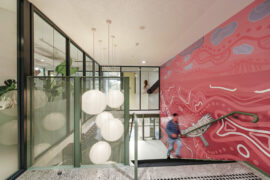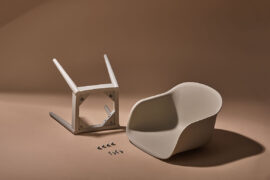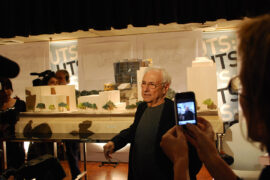Humanscale’s Chief Sustainability Officer is embarking on a tour of Australia, delivering a talk entitled: “Sustainable by Design: Materials Transparency for a Healthier Planet.” At the same time, the company opens a brand new showroom in Sydney. We met her to find out more.

June 11th, 2025
Jane Abernethy and I sat down to talk, fireside, on a Sydney CBD hotel rooftop on the cusp of winter, the city finally emerging from one of its seemingly endless rainy spells. As Chief Sustainability Officer at Humanscale, the New York-based designer and manufacturer of ergonomic products for the workplace, she is obviously concerned with the climate crisis. We spoke about sustainability on both a macro and micro scale – from points specific to furniture and design industries to issues at a societal and global level.
As an industrial designer by training, Abernethy brings a particular mindset and set of skills to bear upon questions of sustainability. “I think designers have to hone certain skills that are probably useful in other fields, but which don’t explicitly require [those skills],” she says. “I remember being in design school and hearing one of my professors, say, ‘nobody wants a toaster; they just want toast.’ And so you have to understand what the actual problem is that you’re solving. In sustainability, I feel that this was kind of one of my secret weapons – instead of saying, ‘hey, we need to make this replacement,’ it was more like, ‘what are we trying to aim for?’”
Tackling sustainability with a design process mindset, then, has something to do with clarity of vision for Abernethy. It’s about being able to rigorously identify the core problem and tackle it with creative solutions, rather than getting lost in surface issues. “Let’s try to see what is the real issue that we’re trying to solve – really unpacking things is something that designers do as part of their profession,” she adds.
Working on sustainability at Humanscale, Abernethy’s approach is very much focused on real-world examples. Reuse, recycling, circular economy, material innovation – these all form part of the philosophy, she says, but “the ultimate goal is to design, procure and use materials in ways that helps us fit in and give back to the planet.”

Abernethy explains that one of the core applications of this approach at Humanscale is about offering products with genuine longevity in mind. “If we want to use resources responsibly, we should use them for as long as possible,” she explains. “One way to get people to do that is to have them really enjoy the products that they use.”
Longevity is an excellent example of how sustainability principles can be applied effectively in furniture design and manufacturing. Instead of working at an architectural scale – with all its slowness and waste – furniture presents opportunities to engage with immediate use patterns. Abernethy talks about people having a connection with products that they use: “I think that feeds into more sustainability; if you have that connection, people will hopefully use their products for longer.”


Of course, one of the keys to creating products that connect with people is good design. “I often find maybe designers don’t realise how much influence and power they have,” observes Abernethy. “They’re often specifying a large quantity, so they have a chance to influence manufacturers, and then that influence is repeated in mass production. That’s a great leverage point.”
Similarly, the scale of Humanscale as a company can also be helpful and have its sustainability advantages. “We’re big enough to make some demands of suppliers and to make some changes, but we’re small enough to still be nimble,” notes Abernethy.
Biomimicry is another area that Abernethy points to, with exciting future possibilities in mind. In keeping with the focus on an end goal of simply ‘fitting in’ with life on the planet and our natural environment, it’s about looking for ideas and solutions from the natural world.
“Biomimicry is the idea of really learning about nature – not just for materials, strategies or mechanisms, but also for an overall approach to how to be in the world. There are so many solutions out there in nature… we just need to look and see – and find,” she reflects.



Humanscale has already pioneered a number of notable approaches with sustainability, such as removing significant levels of toxic ingredients from products and including ocean plastic in them. Abernethy remains focused on those clearly defined goals of sustainability, as well as using design skills to get there. Meanwhile, visits such as this one to Australia – also marking the opening of Humanscale’s new showroom in Sydney – allow for contact with clients and other stakeholders away from her North American home.
“When we share what we’ve done, it can shift the expectations for designers, for specifiers, even for clients,” concludes Abernethy. “When they start to expect more – when they actually think it’s possible and they demand more – then the whole industry has to step up, and so that gets me excited about the possibilities. Part of the reason I’m excited to share what we’ve done and what we’re working on is to shift people’s minds to say, look at these things – they are possible. At least one company is doing this. Maybe you can ask other companies to do it as well. Maybe you can set that as your bar and then the whole industry has to step up.”

INDESIGN is on instagram
Follow @indesignlive
A searchable and comprehensive guide for specifying leading products and their suppliers
Keep up to date with the latest and greatest from our industry BFF's!

From the spark of an idea on the page to the launch of new pieces in a showroom is a journey every aspiring industrial and furnishing designer imagines making.

For those who appreciate form as much as function, Gaggenau’s latest induction innovation delivers sculpted precision and effortless flexibility, disappearing seamlessly into the surface when not in use.

In an industry where design intent is often diluted by value management and procurement pressures, Klaro Industrial Design positions manufacturing as a creative ally – allowing commercial interior designers to deliver unique pieces aligned to the project’s original vision.

From radical material reuse to office-to-school transformations, these five projects show how circular thinking is reshaping architecture, interiors and community spaces.

Designed by Woods Bagot, the new fit-out of a major resources company transforms 40,000-square-metres across 19 levels into interconnected villages that celebrate Western Australia’s diverse terrain.
The internet never sleeps! Here's the stuff you might have missed

MillerKnoll releases the 2025 Better World Report showcasing how design can drive meaningful change through measurable progress across social, environmental and governance initiatives

We republish an article in memory of the late architect by UTS, whose Dr Chau Chak Wing Building was Gehry’s first built project in Australia. The internationally revered architect passed away on 5th December.